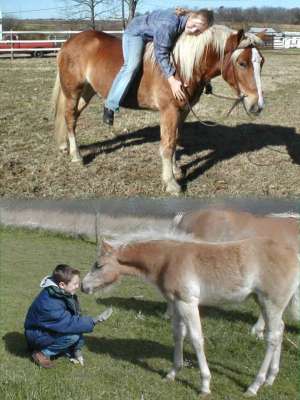The Haflinger is an old breed of small horse that originated in the mountains of the Austrian Tyrol. The name comes from the village of Hafling, part of Austria prior to the end of World War I, but now, located in Italy. The beginning of today's Haflinger can be traced to the year 1874 and the birth of the stallion, "249 Folie," out of a refined, native Tyrolean mare and sired by the half-Arab stallion, "133 El' Bedavi XXII." All purebred Haflingers trace their lineage to this stallion.
The Haflinger came to North America in 1958. Tempel Smith of Tempel Farms, Wadsworth, Illinois, imported them from Austria to begin a breeding program along with his imported Lippizzan horses. Others soon began importing Haflingers, and today there are a number of importers and breeders throughout the United States and Canada. While Haflingers are imported from Germany, Holland, England, and Italy, most continue to come from Austria.
Haflingers are:
Generally docile and less jumpy than other breeds
Smaller (up to 60 inches) but heavily muscled and able to carry large riders easily
Quiet and steady
Not as intimidating as a larger breed
Why is it called a Haflinger?
Haflingers were originally bred in Hafling, Austria, which is now part of Italy.
Haflinger Characteristics
Haflinger horses soon become a special member of the family. They have a genuine friendliness for people, a willing attitude and a sincere desire to please. Haflingers are strong and sturdy, capable of doing the work of much larger horses, with a lower level of care and maintenance. They are easy keepers, long lived, intelligent and easy to train. Being a quiet steady horse, haflingers are less fearful and especially suited for first-time horse owners as well as children’s mounts. Many times our trainer or farrier has commented on how a haflinger just calmly looks at you when another breed would have bolted.
Origins of the Haflinger
 Haflingers were originally bred in the mountains of the Austrian Tyrol. They are strong and sturdy mountain horses used for farm work, packing and driving. All purebred Haflingers trace their roots to a stallion named 249 Folie.
Haflingers were originally bred in the mountains of the Austrian Tyrol. They are strong and sturdy mountain horses used for farm work, packing and driving. All purebred Haflingers trace their roots to a stallion named 249 Folie.
Haflingers were first imported to the United States in 1958 by Tempel Smith of Tempel Farms, Illinois. Today there are a number of farms importing and breeding top quality Haflingers from several countries. Haflingers are very popular in European countries and are rapidly gaining popularity in the United States.
Haflinger Horse Breed Standard
Haflingers come in a variety of sizes and shades, but the breed standard may be able to give you more of an idea of what to expect when looking for the perfect haflinger for your family. Most haflingers range from 53-59 inches tall and weigh 800-1300 pounds. They have a small, flat, slightly dished head with wide spaced eyes and small ears, strong arched neck and a well sprung body. They have a broad chest and rump, and strong well-tapered legs with large hard hooves. They are usually in a shade of chestnut ranging from very light blonde to chocolate solid or with dappling. Haflinger manes and tails can be very thick and even double, and come in shades of white to flaxen.
What about their names?
With the Haflinger breed, colts follow the same beginning letter as their father, and fillies the same beginning letter as their mother. For example, our mare Dandy Sue had a filly, whose name needed to start with a D. We picked Dawn's Early Light. Another mare Shea also produced a filly, which we named Serengeti.
One addition to this is the ST line of stallions, where the names start with St. There are several stallion lines in the Haflinger breed, including A, M, N, S, ST, W, and B. There are quite a few more mare lines.